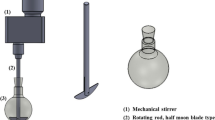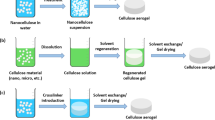Abstract
Porous zirconia capillaries were fabricated and characterized combining extrusion molding and sacrificial template technique. Colloidally stable ceramic paste made of two yttria-stabilized zirconia particle sizes, decane, hexane, stearic acid and beeswax was prepared and extruded, leading to different porosities. To confer mechanical stability to the capillaries, a thermal treatment was conducted at 1438 K. The surface of the ceramic microtubes was functionalized in order to promote click chemistry and immobilize acetylene functionalized enzymes on it. Furthermore, introducing a hydrothermal activation on the ceramic surface had a beneficial effect on further deposition of APTES. The open porosity of the samples ranged from 50 to 56% and water permeate flux from 140 up to 388 L/(m2 h bar). Characteristic flexural strength up to 76 MPa was recorded for the samples with the blend of the zirconia powders. Moreover, a trend could be observed, decreasing the zirconia particle size enhanced the mechanical strength of the sintered bodies. On the other hand, the intrinsic permeability has decreased. Regarding enzyme activity, capillaries with larger zirconia particle size led to better enzyme activity results. Porous zirconia capillaries show a promising future for immobilized enzyme applications under flow regime.

Source: author

Source: author

Source: author

Source: author

Source: author

Source: author

Source: author

Source: author

Source: author

Source: author

Source: author
Similar content being viewed by others
References
Zimmerman M, Snow B (2012) An introduction to nutrition. Creative Commons
Turnbough M, Martos M (2018) What are proteins. https://askabiologist.asu.edu/venom/what-are-proteins. Accessed 13 March 2018
Koopman R et al (2009) Ingestion of a protein hydrolysate is accompanied by an accelerated in vivo digestion and absorption rate when compared with its intact protein. Am J Clin Nutr 90(1):106–115. https://doi.org/10.3945/ajcn.2009.27474
Sewczyk T, Hoog Antink M, Maas M, Kroll S, Beutel S (2018) Flow rate dependent continuous hydrolysis of protein isolates. AMB Express 8:18. https://doi.org/10.1186/s13568-018-0548-9
Godfrey T, Reichelt J (1982) Industrial enzymology: the application of enzymes in industry. Nature Press, New York
Pasupuleti VK, Braun S (2010) State of the art manufacturing of protein hydrolysates. In: Pasupuleti VK, Demain AL (eds) Protein hydrolysates in biotechnology. Springer, Dordrecht, pp 11–32
Hou Y, Wu Z, Dai Z, Wang G, Wu G (2017) Protein hydrolysates in animal nutrition: Industrial production, bioactive peptides, and functional significance. J Anim Sci Biotechnol 8(1):24. https://doi.org/10.1186/s40104-017-0153-9
Moehlenbrock MJ, Minteer SD (2017) Introduction to the field of enzyme immobilization and stabilization. In: Minteer SD (ed) Enzyme stabilization and immobilization: methods and protocols. Springer, New York, pp 1–7
Hanefeld U, Gardossi L, Magner E (2009) Understanding enzyme immobilisation. Chem Soc Rev 38(2):453–468. https://doi.org/10.1039/b711564b
Zheng M, Mao L, Huang F, Xiang X, Deng Q, Feng Y (2015) A mixed-function-grafted magnetic mesoporous hollow silica microsphere immobilized lipase strategy for ultrafast transesterification in a solvent-free system. RSC Adv 5(54):43074–43080. https://doi.org/10.1039/c5ra05611j
Datta S, Christena LR, Rajaram YRS (2013) Enzyme immobilization: an overview on techniques and support materials. 3 Biotech 3(1):1–9. https://doi.org/10.1007/s13205-012-0071-7
Lv Y, Yang H-C, Liang H-Q, Wan L-S, Xu Z-K (2016) Novel nanofiltration membrane with ultrathin zirconia film as selective layer. J Membr Sci 500:265–271. https://doi.org/10.1016/j.memsci.2015.11.046
Wenten IG (2005) Recent development in membrane and its industrial applications. Presented at Membrane Technology in Oil and Gas Industry, Jakarta
Garmash EP, Kryuchkov YN, Pavlikov VN (1995) Ceramic membranes for ultra- and microfiltration (review). Glass Ceram 52(6):150–152. https://doi.org/10.1007/bf00679945
Lee M, Wu Z, Li K (2015) “2 - Advances in ceramic membranes for water treatment. Advances in membrane technologies for water treatment. Woodhead Publishing, Oxford, pp 43–82
Bouzerara F, Harabi A, Ghouil B, Medjemem N, Boudaira B, Condom S (2012) Elaboration and properties of zirconia microfiltration membranes. Procedia Eng 33:278–284. https://doi.org/10.1016/j.proeng.2012.01.1205
Shojai F, Mäntylä T (2001) Monoclinic zirconia microfiltration membranes: preparation and characterization. J Porous Mater 8(2):129–142
Kim J, Lin YS (1998) Sol-gel synthesis and characterization of yttria stabilized zirconia membranes. J Membr Sci 139(1):75–83. https://doi.org/10.1016/S0376-7388(97)00250-0
Bouwmeester HJM, Burggraaf AJ (1996) Chapter 10 Dense ceramic membranes for oxygen separation. In: Burggraaf AJ, Cot L (eds) Membrane science and technology, vol 4. Elsevier, Amsterdam, pp 435–528
Larbot A, Gazagnes L, Krajewski S, Bukowska M, Wojciech K (2004) Water desalination using ceramic membrane distillation. Desalination 168:367–372. https://doi.org/10.1016/j.desal.2004.07.021
Kroll S, Brandes C, Wehling J, Treccani L, Grathwohl G, Rezwan K (2012) Highly efficient enzyme-functionalized porous zirconia microtubes for bacteria filtration. Environ Sci Technol 46(16):8739–8747
Kroll S, Treccani L, Rezwan K, Grathwohl G (2010) Development and characterisation of functionalised ceramic microtubes for bacteria filtration. J Membr Sci 365(1):447–455
Moses JE, Moorhouse AD (2007) The growing applications of click chemistry. Chem Soc Rev 36(8):1249–1262. https://doi.org/10.1039/b613014n
Hermanson GT (2013) Bioconjugate techniques, 3rd edn. Academic Press, London
Zilli M (2016) Internship report. Advanced Ceramics, Bremen
Werner J, Besser B, Brandes C, Kroll S, Rezwan K (2014) Production of ceramic membranes with different pore sizes for virus retention. J Water Process Eng 4:201–211
Reed JS (1995) Principles of ceramics processing, 2nd edn. Wiley, New York
Blendell JE (2001) Solid-state Sintering. In: Buschow KHJ et al (eds) Encyclopedia of materials: science and technology. Elsevier, Oxford, pp 8745–8750
Lee WE, Rainforth WM (1994) Ceramic microstructures: property control by processing. Chapman & Hall, London
Bordia RK, Kang S-JL, Olevsky EA (2017) Current understanding and future research directions at the onset of the next century of sintering science and technology. J Am Ceram Soc 100(6):2314–2352. https://doi.org/10.1111/jace.14919
Giesche H (2006) Mercury porosimetry: a general (practical) overview. Part Part Syst Charact 23(1):1–11
Guo S et al (2017) Statistical analysis on the mechanical properties of magnesium alloys. Materials 10:1271. https://doi.org/10.3390/ma10111271
Scheffler M, Colombo P (2005) Cellular ceramics: structure, manufacturing, properties and applications. Wiley-VCH, Weinheim
Wikipedia (2018) Darcy’s law. Wikipedia. http://en.wikipedia.org/wiki/Darcy%27s_law. Accessed 18th Feb 2018
Acknowledgements
The authors wish to thank the Advanced Ceramics group, at the University of Bremen, in Germany, for the use of the facilities and development of the research. Thanks to Professor Dachamir Hotza for his continuous support and help. The authors also thank Conselho Nacional de Desenvolvimento Científico e Tecnológico (CNPq) for financial support of one of the authors. Thanks are also extended to the Federal University of Santa Catarina for financial support for the other author as a visiting professor.
Author information
Authors and Affiliations
Corresponding author
Additional information
Technical Editor: Adriano Almeida Gonçalves Siqueira.
Publisher's Note
Springer Nature remains neutral with regard to jurisdictional claims in published maps and institutional affiliations.
Rights and permissions
About this article
Cite this article
Tajiri, H.A., Al-Qureshi, H.A. Manufacturing and characterization of porous ceramic capillary membranes for enzyme functionalization through click chemistry. J Braz. Soc. Mech. Sci. Eng. 42, 170 (2020). https://doi.org/10.1007/s40430-020-2254-1
Received:
Accepted:
Published:
DOI: https://doi.org/10.1007/s40430-020-2254-1




